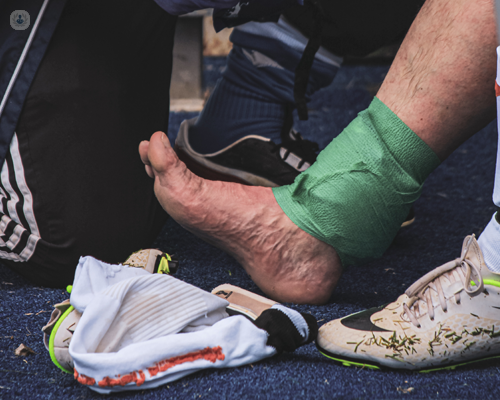Different types of ankle sports injuries and their treatment
Written in association with:Mr Gavin Heyes, a leading trauma and orthopaedic surgeon who specialises in foot and ankle surgery, discusses the various ankle sports injuries you can have - and how they’re treated - in this informative article.

What are common ankle sports injuries?
Ankle injuries are prevalent in sports and can range from mild sprains to severe fractures. Common injuries include ankle sprains, Achilles tendonitis, fractures, and ligament tears. These injuries often occur during activities that involve running, jumping or sudden changes in direction.
What is an ankle sprain?
An ankle sprain occurs when the ligaments that support the ankle are stretched or torn. It’s one of the most common sports injuries. Symptoms include pain, swelling, bruising and difficulty walking. Sprains are classified into three grades:
- Grade 1 (mild): Ligaments are stretched but not torn
- Grade 2 (moderate): Partial tearing of ligaments
- Grade 3 (severe): Complete tear of the ligaments
How is an ankle sprain treated?
Treatment for an ankle sprain typically involves the RICE method: Rest, Ice, Compression and Elevation. Over-the-counter pain relief and anti-inflammatory medications can help manage pain and swelling. Severe sprains may require immobilisation with a brace or cast, and physical therapy to restore strength and mobility.
What is Achilles tendonitis?
Achilles tendonitis is an overuse injury affecting the Achilles tendon, which connects the calf muscles to the heel bone. It’s common in athletes who participate in sports that involve running and jumping. Symptoms include pain and stiffness along the Achilles tendon, especially in the morning or after physical activity.
How is Achilles tendonitis treated?
Treatment for Achilles tendonitis focuses on reducing pain and inflammation, as well as promoting healing. This can involve rest, ice application, and non-steroidal anti-inflammatory drugs (NSAIDs). Stretching and strengthening exercises for the calf muscles are also important. In some cases, physical therapy or orthotic devices may be recommended.
What are ankle fractures?
Ankle fractures occur when one or more bones in the ankle joint are broken. This type of injury often results from a high-impact event, such as a fall, collision or sudden twist. Symptoms include severe pain, swelling, bruising and an inability to bear weight on the affected foot.
How are ankle fractures treated?
Treatment for an ankle fracture depends on the severity and location of the break. Minor fractures may be treated with a cast or brace to immobilise the ankle. More severe fractures may require surgical intervention to realign and stabilise the bones using screws, plates, or rods. Post-surgery rehabilitation is crucial for recovery and typically involves physical therapy to restore strength and mobility.
What is an ankle ligament tear?
Ankle ligament tears occur when the ligaments, which provide stability to the ankle, are completely torn. This injury is more severe than a sprain and can result from trauma or extreme stress on the ankle. Symptoms include:
- intense pain;
- swelling;
- bruising, and;
- joint instability.
How are ankle ligament tears treated?
Treatment for an ankle ligament tear may start with the RICE method and NSAIDs to manage pain and swelling. Immobilisation with a brace or cast is often necessary. Severe cases may require surgical repair to reattach the torn ligaments. Post-surgery rehabilitation includes physical therapy to restore normal function and prevent future injuries.
How can ankle sports injuries be prevented?
Preventing ankle sports injuries involves proper training, conditioning and the use of appropriate footwear. Strengthening exercises for the ankle and lower leg, as well as flexibility routines, can reduce the risk of injury. Athletes should also be mindful of their playing surfaces and avoid overtraining.
Ankle sports injuries are common and can significantly impact athletic performance and daily activities. Early diagnosis and appropriate treatment are essential for effective recovery. If you suspect an ankle injury, it’s important to seek medical attention to determine the best course of action and prevent long-term complications.
If you require expert treatment for an ankle sports injury, arrange a consultation with Mr Heyes via his Top Doctors profile.


